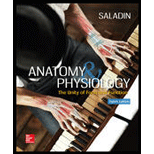
Anatomy & Physiology: The Unity of Form and Function
8th Edition
ISBN: 9781259277726
Author: Kenneth S. Saladin Dr.
Publisher: McGraw-Hill Education
expand_more
expand_more
format_list_bulleted
Question
Chapter 26.1, Problem 29AYLO
Summary Introduction
To discuss:
The general history of human salt consumption; the recommended daily intake of sodium and some reasons why most U.S. diets greatly exceed this; and the consequences of excessive sodium intake.
Introduction:
Minerals are micronutrients that are required by the body in trace amounts. These minerals are obtained from the water and soils, and they entered into the food web. This is essential for the body for the intake of other nutrients. These are essential nutrients that have important effects on the body. Excessive intake of minerals results in lethal and toxic effects. One of the major mineral is sodium, which maintains the regulation of water and electrolytes.
Expert Solution & Answer
Want to see the full answer?
Check out a sample textbook solution
Students have asked these similar questions
The role of low-density lipoprotein in chronic heart disease and familial hypercholesteremia
Significance of proteins in urine and the various methods for measurement of urinary total protein.
the role of high density lipoprotein in chronic heart disease and familial hypercholesteremia
Chapter 26 Solutions
Anatomy & Physiology: The Unity of Form and Function
Ch. 26.1 - Prob. 1AYLOCh. 26.1 - Prob. 2AYLOCh. 26.1 - Prob. 3AYLOCh. 26.1 - Prob. 4AYLOCh. 26.1 - Roles of the arcuate nucleus, neuropeptide YY, and...Ch. 26.1 - Prob. 6AYLOCh. 26.1 - Prob. 7AYLOCh. 26.1 - Prob. 8AYLOCh. 26.1 - Principal dietary sources of calories; the...Ch. 26.1 - Prob. 10AYLO
Ch. 26.1 - Prob. 11AYLOCh. 26.1 - Prob. 12AYLOCh. 26.1 - Prob. 13AYLOCh. 26.1 - Prob. 14AYLOCh. 26.1 - Prob. 15AYLOCh. 26.1 - Prob. 16AYLOCh. 26.1 - Prob. 17AYLOCh. 26.1 - Prob. 18AYLOCh. 26.1 - Prob. 19AYLOCh. 26.1 - Prob. 20AYLOCh. 26.1 - Prob. 21AYLOCh. 26.1 - Prob. 22AYLOCh. 26.1 - Type of lipoproteins found in the...Ch. 26.1 - Prob. 24AYLOCh. 26.1 - Prob. 25AYLOCh. 26.1 - Prob. 26AYLOCh. 26.1 - Prob. 27AYLOCh. 26.1 - Prob. 28AYLOCh. 26.1 - Prob. 29AYLOCh. 26.1 - Prob. 30AYLOCh. 26.1 - Prob. 1BYGOCh. 26.1 - Prob. 2BYGOCh. 26.1 - What class of nutrients provides most of the...Ch. 26.1 - Prob. 4BYGOCh. 26.1 - Prob. 5BYGOCh. 26.2 - Prob. 1AYLOCh. 26.2 - Function of the coenzymes NAD+ and FAD in glucose...Ch. 26.2 - Prob. 3AYLOCh. 26.2 - Anaerobic fermentation and its primary purposeCh. 26.2 - Prob. 5AYLOCh. 26.2 - Prob. 6AYLOCh. 26.2 - Prob. 7AYLOCh. 26.2 - Prob. 8AYLOCh. 26.2 - The net ATP yield of glycolysis and aerobic...Ch. 26.2 - The efficiency of aerobic respiration and how to...Ch. 26.2 - How excess glucose is convened to glycogen; the...Ch. 26.2 - Prob. 6BYGOCh. 26.2 - Prob. 7BYGOCh. 26.2 - Prob. 8BYGOCh. 26.2 - Prob. 9BYGOCh. 26.2 - What important enzyme is found in the inner...Ch. 26.2 - Prob. 11BYGOCh. 26.3 - What cells are primarily responsible for storing...Ch. 26.3 - The process of lipolysis including the hydrolysis...Ch. 26.3 - Prob. 3AYLOCh. 26.3 - Prob. 4AYLOCh. 26.3 - Prob. 5AYLOCh. 26.3 - Prob. 6AYLOCh. 26.3 - Prob. 7AYLOCh. 26.3 - How the liver produces ureaCh. 26.3 - Other nondigestive functions of the liverCh. 26.3 - Prob. 12BYGOCh. 26.3 - Prob. 13BYGOCh. 26.3 - Prob. 14BYGOCh. 26.4 - Prob. 1AYLOCh. 26.4 - Prob. 2AYLOCh. 26.4 - When the body is in its postabsorptive state; what...Ch. 26.4 - Hormones that regulate the postabsorptive state,...Ch. 26.4 - Prob. 5AYLOCh. 26.4 - Prob. 6AYLOCh. 26.4 - Prob. 15BYGOCh. 26.4 - Prob. 16BYGOCh. 26.4 - Prob. 17BYGOCh. 26.4 - Prob. 18BYGOCh. 26.5 - Prob. 1AYLOCh. 26.5 - Prob. 2AYLOCh. 26.5 - Prob. 3AYLOCh. 26.5 - Prob. 4AYLOCh. 26.5 - Prob. 5AYLOCh. 26.5 - Prob. 6AYLOCh. 26.5 - Prob. 7AYLOCh. 26.5 - Prob. 8AYLOCh. 26.5 - Prob. 9AYLOCh. 26.5 - Prob. 19BYGOCh. 26.5 - Prob. 20BYGOCh. 26.5 - Prob. 21BYGOCh. 26.5 - Prob. 22BYGOCh. 26 - Prob. 1TYRCh. 26 - Prob. 2TYRCh. 26 - Prob. 3TYRCh. 26 - The lipoproteins that remove cholesterol from the...Ch. 26 - Which of the following is most likely to make you...Ch. 26 - Prob. 6TYRCh. 26 - FAD is reduced to FADH2 in a. glycolysis. b....Ch. 26 - Prob. 8TYRCh. 26 - Prob. 9TYRCh. 26 - Prob. 10TYRCh. 26 - Prob. 11TYRCh. 26 - Prob. 12TYRCh. 26 - Synthesis of glucose from amino acids or...Ch. 26 - Prob. 14TYRCh. 26 - Prob. 15TYRCh. 26 - Prob. 16TYRCh. 26 - Prob. 17TYRCh. 26 - The appetite hormones ghrelin, leptin, CCK, and...Ch. 26 - The brightly colored, iron-containing,...Ch. 26 - Prob. 20TYRCh. 26 - Prob. 1BYMVCh. 26 - Prob. 2BYMVCh. 26 - Prob. 3BYMVCh. 26 - Prob. 4BYMVCh. 26 - Prob. 5BYMVCh. 26 - Prob. 6BYMVCh. 26 - Prob. 7BYMVCh. 26 - Prob. 8BYMVCh. 26 - Prob. 9BYMVCh. 26 - Prob. 10BYMVCh. 26 - Prob. 1WWTSCh. 26 - Prob. 2WWTSCh. 26 - Prob. 3WWTSCh. 26 - Most of the body's cholesterol comes from the...Ch. 26 - Prob. 5WWTSCh. 26 - Prob. 6WWTSCh. 26 - Prob. 7WWTSCh. 26 - Prob. 8WWTSCh. 26 - Prob. 9WWTSCh. 26 - Prob. 10WWTSCh. 26 - Prob. 1TYCCh. 26 - Chapter 17 defines and describes some hormone...Ch. 26 - Prob. 3TYCCh. 26 - A Television advertisement proclaims. "Feeling...Ch. 26 - Explain why a patient whose liver has been...
Knowledge Booster
Learn more about
Need a deep-dive on the concept behind this application? Look no further. Learn more about this topic, biology and related others by exploring similar questions and additional content below.Similar questions
arrow_back_ios
arrow_forward_ios
Recommended textbooks for you
- Understanding Health Insurance: A Guide to Billin...Health & NutritionISBN:9781337679480Author:GREENPublisher:Cengage

Understanding Health Insurance: A Guide to Billin...
Health & Nutrition
ISBN:9781337679480
Author:GREEN
Publisher:Cengage
Excretory System; Author: Amoeba Sisters;https://www.youtube.com/watch?v=q5qaGHfdmYM;License: Standard youtube license